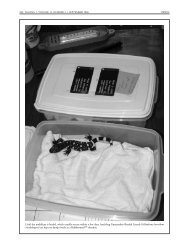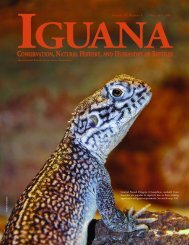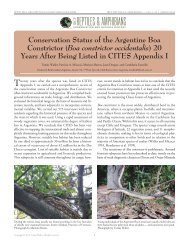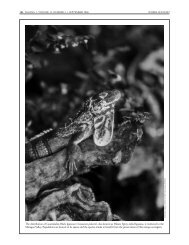Spiny-tailed Iguanas (Ctenosaura similis) in Venezuela
Spiny-tailed Iguanas (Ctenosaura similis) in Venezuela
Spiny-tailed Iguanas (Ctenosaura similis) in Venezuela
Create successful ePaper yourself
Turn your PDF publications into a flip-book with our unique Google optimized e-Paper software.
ROBERT POWELL<br />
DOMINICAN RACERS<br />
Alsophis antillensis sibonius is endemic to Dom<strong>in</strong>ica, Lesser<br />
Antilles. Although Schwartz and Henderson (1991)<br />
described adults, thorough descriptions of juveniles have not<br />
been published. Dur<strong>in</strong>g a June 2008 study conducted primarily<br />
at Cabrits National Park, we made >160 observations of an<br />
undeterm<strong>in</strong>ed number of snakes. Included <strong>in</strong> the observations<br />
were five juveniles, for four of which we collected and recorded<br />
pattern data. The only previous description of the juvenile pattern<br />
was by Parker (1933): “… an undulat<strong>in</strong>g dark vertebral<br />
stripe, a narrow lateral l<strong>in</strong>e, and dark spots on the flanks and<br />
h<strong>in</strong>der parts of the belly.”<br />
The top of the head <strong>in</strong> juveniles is uniformly brown, darken<strong>in</strong>g<br />
laterally, with very dark brown to black l<strong>in</strong>es extend<strong>in</strong>g<br />
IGUANA • VOLUME 15, NUMBER 3 • SEPTEMBER 2008 157<br />
Agriculture & the Environment, Commonwealth of Dom<strong>in</strong>ica,<br />
was <strong>in</strong>strumental <strong>in</strong> issu<strong>in</strong>g permits to conduct research <strong>in</strong><br />
Dom<strong>in</strong>ica and facilitated our efforts <strong>in</strong> myriad ways. Fieldwork<br />
was funded by a grant from the National Science Foundation<br />
(USA) to Robert Powell (DBI-0242589).<br />
Literature Cited<br />
Henderson, R.W. and R. Powell. 2009. Natural History of West Indian<br />
Amphibians and Reptiles. University Press of Florida, Ga<strong>in</strong>esville.<br />
Perry, G. and R.N. Fisher. 2006. Night lights and reptiles: Observed and potential<br />
effects, pp. 169–191. In: C. Rich and T. Longcore (eds.), Ecological<br />
Consequences of Artificial Night Light<strong>in</strong>g. Island Press, Wash<strong>in</strong>gton, D.C.<br />
Perry, G. and J. Lazell. 2000. Liophis portoricensis anegadae (NCN). Night-light<br />
hunt<strong>in</strong>g. Herpetological Review 31:247.<br />
Juvenile Pattern and Ontogenetic Pattern<br />
Changes <strong>in</strong> Dom<strong>in</strong>ican Racers<br />
Lauren A. White 1 and Peter J. Muelleman 2<br />
A Dom<strong>in</strong>ican Racer (Alsophis antillensis sibonius) <strong>in</strong> a forag<strong>in</strong>g position<br />
at the base of a light such as that illustrated on the fac<strong>in</strong>g page. This<br />
forag<strong>in</strong>g posture, with the anterior portion of the body elevated at the<br />
base of the light, is essentially similar to that observed <strong>in</strong> snakes at the<br />
bases of tree trunks <strong>in</strong> more “natural” habitats (L.A. White and P.J.<br />
Muelleman, pers. comm.).<br />
1 Environmental Science Program, Oklahoma State University, Stillwater, Oklahoma 74078, USA (lauren.a.white@okstate.edu)<br />
2 Department of Biology, Truman State University, Kirksville, Missouri 63501, USA (pjm563@truman.edu)<br />
<br />
from the snout and through the eyes before blend<strong>in</strong>g <strong>in</strong>to the<br />
darker elements of the body pattern. Supralabials are white,<br />
sometimes with fa<strong>in</strong>t specks of light brown or gray. Fa<strong>in</strong>t to<br />
moderately dist<strong>in</strong>ct stippl<strong>in</strong>g occurs on <strong>in</strong>fralabials, ch<strong>in</strong>, and<br />
throat.<br />
Juveniles have dist<strong>in</strong>ct brown middorsal “saddles” fa<strong>in</strong>tly<br />
outl<strong>in</strong>ed <strong>in</strong> black on a white to pale gray or tan ground color.<br />
Most saddles on any one <strong>in</strong>dividual are <strong>in</strong> contact, form<strong>in</strong>g a<br />
cont<strong>in</strong>uous middorsal l<strong>in</strong>e with paired lateral extensions. These<br />
saddles may be obliquely situated or offset, form<strong>in</strong>g a wavy<br />
(“zigzag”) l<strong>in</strong>e along at least portions of the dorsum. At least a<br />
few saddles on each animal are isolated by pale ground color<br />
extend<strong>in</strong>g across the middorsal l<strong>in</strong>e. On all juveniles exam<strong>in</strong>ed,








